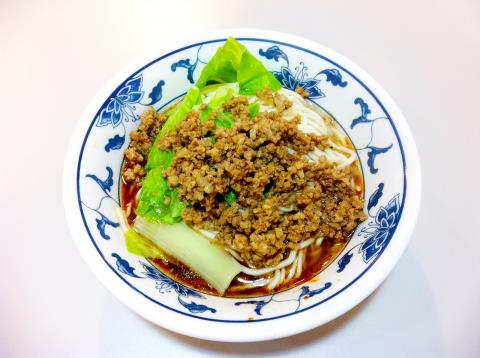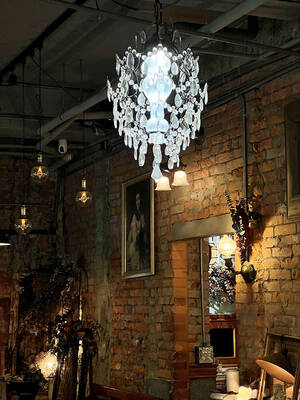Bored with your regular noodle joint? Nan Chung (南川), a new shop on the corner of Anhe and Heping East roads in Taipei, will spice up your bowl.
The restaurant, which also has a branch in Sindian (新店), specializes in Sichuan-style noodles, meaning that diners can expect plenty of mala (麻辣, literally “numb and spicy”) in their meals.
Nan Chung — which translates as “southern Sichuan” (the restaurant got creative with the Romanized spelling of its English name; the “Chung” should be spelled and pronounced “Chuan” in Hanyu Pinyin) — has been pulling in sizable lunchtime crowds since it opened several weeks ago, and it’s easy to see why. The food is excellent.

Photo: David Chen, Taipei Times
It wasn’t even the noodles that convinced me — Nan Chung had already won me over with its appetizers. Before my first visit, a friend got takeout and offered me a few bites of one of the restaurant’s cold dish specialties, mala chicken (麻辣雞, NT$120).
This one is a must-try. The chicken slices, all white meat cuts, were perfectly tender and dressed in a reddish, mildly spicy mala sauce with a rich mix of flavors, ranging from sweet and piquant to smoky and nutty.
Nan Chung offers a wide selection of “dry” noodles (ganmian, 乾麵). On your first visit, go for the house specialty, sujiao zhajiang mian, or literally “pure pepper fried sauce noodles” (素椒炸醬麵, NT$85 for a small bowl, NT$130 for a large bowl). I found everything in this bowl to be perfect — from the balance of chili oil and mala sauce to the topping of minced pork, which was neither too fatty nor too dry, to the thin noodles, which were fresh and cooked al dente.
Other choices include the standard dan-dan noodles (擔擔麵, NT$70 and NT$110), a chili and peanut sauce-doused concoction also recommended by the restaurant. Soup noodle lovers can get their fix, too. Braised beef noodles (紅燒牛肉麵) are NT$120 for a small bowl and NT$180 for a big bowl, wonton noodle soup (鮮肉餛飩麵) is NT$70 or NT$110, and noodle soup with pig trotter (蹄花麵) will set you back either NT$110 or NT$160.
By default, the noodles are served very spicy, but you can ask the chef to go easy. Tell the wait staff that you want xiaola (小辣, slightly spicy).
The larger portions of each noodle dish are enough for a full meal. But it’s more fun and fulfilling to get the smaller portion of noodles and have them with cold dish appetizers such as the aforementioned mala chicken or another house specialty, the smoked chicken. This one isn’t as good as the mala chicken — the meat is a little tougher — but it’s still worth trying for its subtle sweet and soy-sauce based flavor. There are two different cuts of smoked chicken (ask for the xunji, 薰雞) — wings (NT$100) or a chicken leg (NT$120).
Nan Chung is one of the rare noodle shops that puts thought and care into its appetizers. Even run-of-the-mill selections like fried tofu with sliced cucumber on top were fresh and tasted delicious. Other choices include dougan (豆乾), tea eggs and sliced bitter melon. Choose your appetizers as you walk in, but make sure to ask about the prices first, which aren’t listed and range from NT$40 to NT$60 per plate.
Nan Chung’s higher-than-average prices are very much worth it, and its environs are refreshingly modern and comfortable. The interior is adorned with wood paneling and mirrors on the walls, while hanging lamps create a homey feel. I also like how the chef is stationed in the middle of the room behind a large countertop bar, in view of all of the diners. The shelves behind the bar are stocked with the requisite ingredients for Sichuan cooking: cinnamon, star anise, dried orange peel and Sichuan peppercorns (花椒).
I thought about this alchemy of spices as I left the restaurant, my lips buzzing after a bowl of delicious sweet and sour noodles (酸辣麵, NT$70 or NT$110) and my taste buds savoring the sweet, vinegary and smoky flavors that lingered for a while.

The Taipei Times last week reported that the rising share of seniors in the population is reshaping the nation’s housing markets. According to data from the Ministry of the Interior, about 850,000 residences were occupied by elderly people in the first quarter, including 655,000 that housed only one resident. H&B Realty chief researcher Jessica Hsu (徐佳馨), quoted in the article, said that there is rising demand for elderly-friendly housing, including units with elevators, barrier-free layouts and proximity to healthcare services. Hsu and others cited in the article highlighted the changing family residential dynamics, as children no longer live with parents,

The classic warmth of a good old-fashioned izakaya beckons you in, all cozy nooks and dark wood finishes, as tables order a third round and waiters sling tapas-sized bites and assorted — sometimes unidentifiable — skewered meats. But there’s a romantic hush about this Ximending (西門町) hotspot, with cocktails savored, plating elegant and never rushed and daters and diners lit by candlelight and chandelier. Each chair is mismatched and the assorted tables appear to be the fanciest picks from a nearby flea market. A naked sewing mannequin stands in a dimly lit corner, adorned with antique mirrors and draped foliage

The election of Cheng Li-wun (鄭麗文) as chair of the Chinese Nationalist Party (KMT) marked a triumphant return of pride in the “Chinese” in the party name. Cheng wants Taiwanese to be proud to call themselves Chinese again. The unambiguous winner was a return to the KMT ideology that formed in the early 2000s under then chairman Lien Chan (連戰) and president Ma Ying-jeou (馬英九) put into practice as far as he could, until ultimately thwarted by hundreds of thousands of protestors thronging the streets in what became known as the Sunflower movement in 2014. Cheng is an unambiguous Chinese ethnonationalist,

I was 10 when I read an article in the local paper about the Air Guitar World Championships, which take place every year in my home town of Oulu, Finland. My parents had helped out at the very first contest back in 1996 — my mum gave out fliers, my dad sorted the music. Since then, national championships have been held all across the world, with the winners assembling in Oulu every summer. At the time, I asked my parents if I could compete. At first they were hesitant; the event was in a bar, and there would be a lot